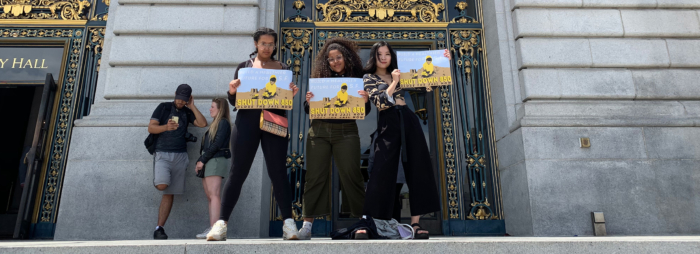
Politics major Mackenzie Rutherford ’21 spent the summer in Oakland, California, as an intern at Critical Resistance, a member-led, grassroots movement that seeks to build an international movement to end the prison industrial complex. In an effort to help people understand this work, Rutherford agreed to an interview with Scripps’ Office of Marketing and Communications. But first, she had to finish a phone with a person currently in prison.
Scripps College: Can you tell us about that phone call?
Mackenzie Rutherford: Yeah, they are only allowed a 15-minute conversation, so it was really important that I stayed on the phone the whole time.
At Critical Resistance, we take prisoner calls and accept prisoner mail. They can call in for basically anything. We do ask that they only call once per week so that we can talk to as many people as possible, but they can really call at any time if it’s urgent. Sometimes they call even just to have someone to talk to. But mostly what they call for are resources—we frequently give them books and our newspaper, The Abolitionist, as well as connect them to legal resources, attorneys, and law offices that can help them. Anything we can do within reason.
SC: What are your other responsibilities as an intern at Critical Resistance?
MR: Being in L.A. County for the majority of the year for school and having done prison abolition work there, I’ve been working on a campaign against the building of new jails in Los Angeles. The Board of Supervisors, in response to widespread protest, had ostensibly scrapped plans to build a men’s jail facility and instead build a mental health treatment center. However, a look at the architectural plans (4,000 beds) and supervisor structure (the facility would fall under the purview of the sheriff) made it apparent that this was clearly a strategic move by the board to continue building under their contract but just calling the project by a different name.
So, I wrote a report about the current status of the jail site, including the contract, the Board of Supervisors’ plan, and the architectural plans. I am also helping with a plan to find sites for decentralized mental health facilities throughout the country to take the place of this proposed centralized facility in downtown L.A. I find sites, map them on county maps, and then give reports on how they could be developed into mental health facilities. We will eventually present this to the Board of Supervisors. Finally, I’ve done a lot of event support in L.A. with alum Jess Heaney ’08, who is the development director at Critical Resistance, like finding a venue for a benefit concert, outreach for the event, and research into grant support.
SC: How did you become interested in the prison abolition movement?
MR: I had thought about the criminal justice system prior to Scripps and the problems of policing and incarceration, but it wasn’t until coming to Scripps and getting involved in the 5C Prison Abolition Club that these ideas really came to the fore. I was recently chosen as co-chair of the club, which I have been involved since the beginning of my first year. A few other members had previously interned for Critical Resistance, so there was already a path for me to intern there.
SC: What is something about the concept of “prison abolition” that not many people know?
MR: It’s part of the push to eradicate what’s called the “prison industrial complex,” which is a series of overlapping systems including policing, surveillance, courts, and imprisonment as a form of social control. A lot of people think of prison as this standout, evil thing, but it’s part of a larger system that includes policing and the media, among other forces, and how they all work together in the prison pipeline. For example, certain areas are policed more heavily, and that necessarily leads to higher rates of arrest and incarceration. So, the way we accept policing as a central aspect of our feelings of safety is also part of targeting communities through control. And that presence of such control disempowers the people in those communities. The media, too, plays a large role in criminalizing communities by showing images and giving biased information that encourages people to think that a criminal is a certain type of person.
SC: What is the alternative to the prison industrial complex?
MR: While many people imagine prison abolition as simply closing down jails and prisons, it is much more than that. What I’ve found especially compelling about CR’s work is that while dismantling systems of oppression, surveillance, and control that enable this system, CR also promotes building up our communities, resources, and people power to decrease the perceived need for policing. Rather than focusing solely on tearing down a violent system, CR focuses on safety, popular education, violence and harm reduction, and community. While I’ve been working on campaigns to shut down a jail in San Francisco and to build a plan for decentralized mental health care in L.A. instead of a new jail, I’ve also been able to work on editing Critical Resistance’s educational workshops to make the organizing strategy more accessible and mainstream as well as event planning to bring communities together to celebrate, communicate, and organize. Prison abolition is about more than getting rid of prisons: it’s a path towards building radical community care, compassion, and ultimately, liberation.
SC: Do you want to continue this type of work after graduation?
MR: I’d like to continue prison abolition work and maybe go to law school, as long as I’m doing something to promote black liberation and social justice.

